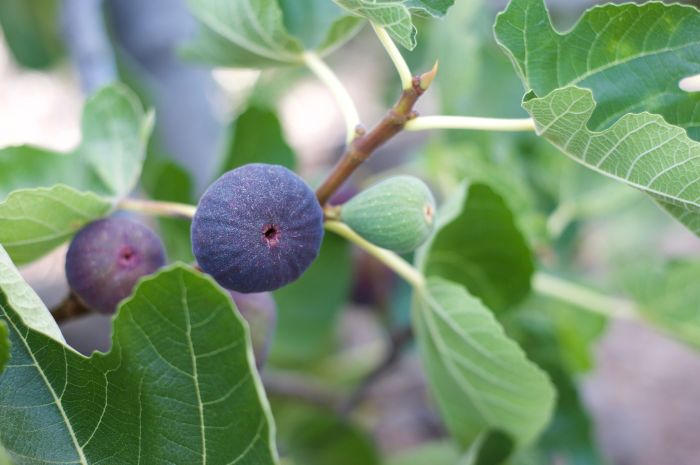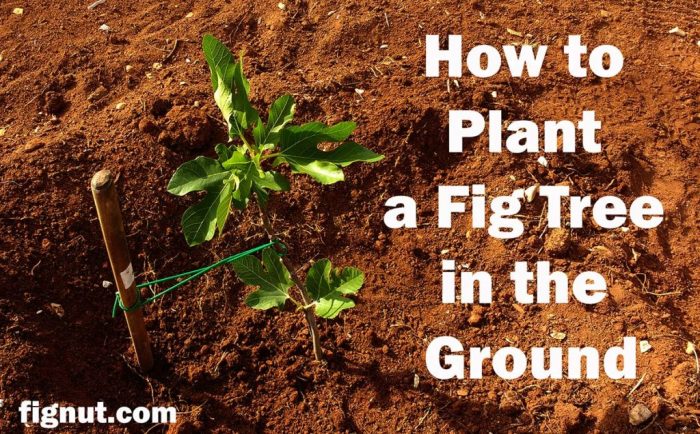Planting the Fig Tree

Plant fig tree in ground – Planting a fig tree, whether bare-root or container-grown, requires careful attention to detail to ensure its successful establishment and future fruit production. Proper planting depth and spacing are crucial for healthy root development and optimal growth. Watering techniques immediately following planting are equally important for minimizing transplant shock and promoting strong root establishment.
Bare-Root Fig Tree Planting
Planting a bare-root fig tree requires a slightly different approach than planting a container-grown tree. The exposed roots need careful handling to prevent damage and ensure proper contact with the soil. The goal is to create a planting hole that allows the roots to spread naturally and establish themselves without being cramped or overly deep.Planting a bare-root fig tree involves these steps: Dig a hole twice as wide as the root spread and just as deep as the root ball.
Gently spread the roots outwards, ensuring they are not tangled or circling. Place the tree in the hole, ensuring the root flare (where the trunk meets the roots) is at or slightly above ground level. Backfill the hole with soil, gently firming it around the roots to eliminate air pockets. Water thoroughly after planting. Proper spacing between trees is essential, typically ranging from 8 to 15 feet depending on the variety and desired size.
Container-Grown Fig Tree Planting, Plant fig tree in ground
Planting a container-grown fig tree is generally less stressful on the plant as the root system is already established and protected. The primary concern is minimizing root disturbance during transplanting. The goal is to carefully remove the tree from its container, preserving the root ball’s integrity, and placing it in a prepared hole that provides ample space for growth.To plant a container-grown fig tree, begin by gently loosening the root ball around the edges of the container.
Slide the tree out of the container, trying to keep the root ball intact. Dig a hole slightly larger than the root ball. Place the tree in the hole, ensuring the top of the root ball is level with the surrounding ground. Backfill the hole with soil, gently firming it around the root ball. Water thoroughly after planting.
Spacing considerations remain similar to bare-root trees, ranging from 8 to 15 feet apart.
Watering Newly Planted Fig Trees
Proper watering is critical for the survival and establishment of newly planted fig trees. Insufficient watering can lead to transplant shock and reduced growth, while overwatering can cause root rot. A consistent watering schedule is essential during the initial weeks and months after planting.Immediately after planting, water deeply and thoroughly to settle the soil around the roots. Continue watering regularly, aiming for consistent soil moisture but avoiding waterlogged conditions.
The frequency of watering will depend on factors such as soil type, climate, and weather conditions. During hot and dry periods, more frequent watering may be necessary. A deep, slow watering method is preferable to shallow, frequent watering, encouraging deeper root growth. Mulching around the base of the tree can help retain soil moisture and reduce the frequency of watering.
Monitor the soil moisture regularly and adjust your watering schedule accordingly. A moisture meter can be helpful in determining when watering is needed.
Planting a fig tree, a temperate-climate species, requires careful consideration of soil drainage and sunlight. Interestingly, the optimal growing conditions contrast sharply with those of the Pachira aquatica, commonly known as the money tree; to understand its needs, consider whether is money tree a tropical plant , a crucial factor in its cultivation. Returning to the fig, proper planting ensures a healthy, fruitful tree, thriving in its preferred environment.
Ongoing Care and Maintenance

Providing consistent care is crucial for a healthy and productive fig tree. Regular watering, fertilization, and pruning are key elements in ensuring your tree thrives and yields a bountiful harvest. Neglecting these aspects can lead to stunted growth, reduced fruit production, and increased susceptibility to pests and diseases. This section details a comprehensive care regimen to help your fig tree flourish.
Watering Schedule
Proper watering is essential for fig tree health. Underwatering can stress the tree, leading to smaller fruit and reduced yields, while overwatering can cause root rot. The ideal watering schedule depends on factors like climate, soil type, and tree age. Young trees generally require more frequent watering than established ones.
| Season | Watering Frequency (Mature Tree) | Watering Frequency (Young Tree) | Notes |
|---|---|---|---|
| Spring | Once a week (unless rain) | Twice a week (unless rain) | Increase frequency during dry spells |
| Summer | Twice a week (unless rain) | Every other day (unless rain) | Monitor soil moisture closely |
| Autumn | Once a week (unless rain) | Twice a week (unless rain) | Reduce frequency as temperatures cool |
| Winter | Infrequently (only if soil is very dry) | Once a week (if soil is very dry) | Water deeply but less often |
Fertilization Plan
Fig trees benefit from regular fertilization to support healthy growth and fruit production. A balanced, slow-release fertilizer is recommended. Avoid over-fertilizing, as this can damage the tree.
| Season | Fertilizer Type | Application Method | Notes |
|---|---|---|---|
| Early Spring | Balanced, slow-release fertilizer (e.g., 10-10-10) | Apply around the drip line | Follow package instructions for application rate |
| Mid-Summer | Balanced, slow-release fertilizer (e.g., 10-10-10) | Apply around the drip line | Apply only if necessary, based on tree growth |
Pruning Techniques
Pruning is vital for maintaining the fig tree’s shape, promoting fruit production, and preventing disease. Regular pruning removes dead, diseased, or crossing branches, improving air circulation and sunlight penetration. This also encourages the growth of strong, productive branches.
Pest and Disease Management
Fig trees are susceptible to various pests and diseases. Early detection and appropriate treatment are crucial to prevent significant damage.
| Pest/Disease | Symptoms | Preventative Strategies | Treatment Strategies |
|---|---|---|---|
| Fig Borer | Holes in branches, wilting, dieback | Maintain tree health, prune damaged branches | Remove infested branches, consider insecticide (if necessary) |
| Fig Rust | Orange pustules on leaves | Ensure good air circulation, remove fallen leaves | Fungicide application may be necessary |
| Leaf Spot Diseases | Spots on leaves, premature leaf drop | Maintain good sanitation, remove fallen leaves | Fungicide application may be necessary |
Key Questions Answered: Plant Fig Tree In Ground
Can I grow a fig tree in a pot?
While fig trees thrive in the ground, you can grow them in large containers, but they may not reach their full potential size and yield.
How often should I water a newly planted fig tree?
Water deeply and regularly, especially during dry spells, to establish a strong root system. Reduce watering frequency as the tree matures.
What is the best time to prune a fig tree?
Late winter or early spring, before new growth begins, is the ideal time for pruning.
How do I prevent fig tree diseases?
Good air circulation, proper watering, and regular inspection for pests and diseases are crucial for prevention. Treat any issues promptly.
What are some common fig pests?
Fig beetles, aphids, and scale insects are common pests that can affect fig trees.
